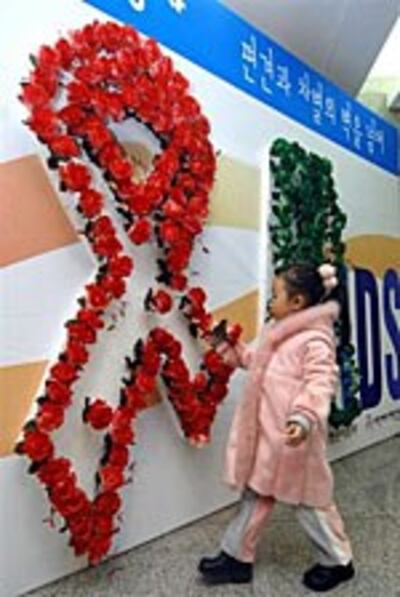
HONG KONG—Infection rates for HIV are increasing in the Asia-Pacific region, with few receiving the treatment they need, according to a report released for World AIDS Day on Dec. 1.
The region saw approximately 630,000 deaths from AIDS-related illnesses in 2006, according to UNAIDS' 2006 Epidemic Update.
The report said that while the number of people receiving antiretroviral therapy in the region had increased more than threefold since 2003, only about 16 percent of the total number of people in need of antiretroviral treatment in Asia were getting it.
Only Thailand succeeded in providing treatment to at least 50 percent of people needing it.
HIV outbreaks among men who have sex with men are now becoming evident in Cambodia, China, India, Nepal, Pakistan, Thailand and Vietnam.
HIV infection risk is associated in Southeast Asian countries with unprotected commercial sex, sex between men, and unsafe injecting drug use, the Update said.
Sex between men key
The report blames the failure of governments to adequately address the role of sex between men in the epidemic.
"HIV outbreaks among men who have sex with men are now becoming evident in Cambodia, China, India, Nepal, Pakistan, Thailand and Vietnam," it said.
"In very few of these countries, national AIDS programmes adequately address the role of sex between men in the epidemics. HIV outbreaks are being found in Afghanistan and Pakistan, particularly among injecting drug users."
It added that high levels of use of non-sterile injecting equipment and other risk behaviours show considerable scope for further growth of the epidemic in those two countries.
The report estimates that around 8.6 million people were living with HIV in Asian countries in 2006, including around 960,000 people who became newly infected in the past year.
Risky behavior key
"Although the number of HIV/AIDS patients used to be lower in Asia than elsewhere, we do have reasons for concern, especially if one considers the number of infected people in countries with big populations," Luiz Loures, director of the global initiatives division at UNAIDS, told RFA's Korean service.
"There are no data available on HIV/AIDS in North Korea, and it is difficult to say whether closed societies can better control the spread of HIV/AIDS, because the virus always finds a way," Loures told Yonho Kim.
"The proliferation of this pandemic is not a matter of how open or closed a society is, but whether people engage in risky behavior or not. If high risk behavior is present, the risk of contracting HIV/AIDS will always be there," he said.
In China, new infections are on the rise among injecting drug users, although half the new infections in China during 2005 occurred during unprotected sex. The virus was spreading gradually from at-risk populations into the general population and there is a rise in the number of infections among women, the report said.
Beijing-based AIDS activist Wan Yanhai said better monitoring was needed of how funding for AIDS prevention and treatment was being used.
"They are inexperienced, and government organizations at all levels keep all the information to themselves," Wan told RFA's Mandarin service.
Wan Yanhai said he suspected some of the AIDS funds were being embezzled, although he did not have any evidence.
"Information is blocked and this results in corruption," Wan told reporter Yan Ming. "Almost all AIDS patients in every locality believe that AIDS funds are not being properly used. They don't know where the money has gone," he said.
Meanwhile, top AIDS author and retired traditional Chinese medicine doctor Gao Yaojie, who has been sued for libel and placed under surveillance by the authorities in the course of her work, said she had turned down approaches from the Henan provincial government, which wanted her to write a book praising its efforts in fighting the epidemic.
She said: "The provincial governor sent other officials to ask me to write the book, but I refused. I told them that if I wrote the book, I would be followed by undercover police."
"I also told them, if you want to write the book, just go ahead, but do not mention my name. A couple of days later, they called me again for the same issue and I repeated what I have told them. I don't want be named on the book and I just don't want to lie," said Gao, who is currently based in Shanghai, lecturing in AIDS prevention.
Vietnam’s epidemic continues to increase, with HIV having been detected in all 64 provinces and all cities. The number of people living with HIV has doubled since 2000 to around 260,000, according to government figures.
The use of non-sterile injecting equipment pushed infection rates among injecting drug users from 9 percent in 1996 to more than 30 percent in 2003. Large proportions of male injecting drug users engage in unprotected sex, including paid sex (40 percent in the northern province of Bac Ninh for example), UNAIDS said.
The need for HIV prevention work among migrant populations in Vietnam and China was also highlighted.
Original reporting in Mandarin by Yan Ming and in Korean by Yonho Kim. RFA Mandarin service director: Jennifer Chou. RFA Korean service director: Jaehoon Ahn. Written and produced by Luisetta Mudie. Edited by Sarah Jackson-Han.
